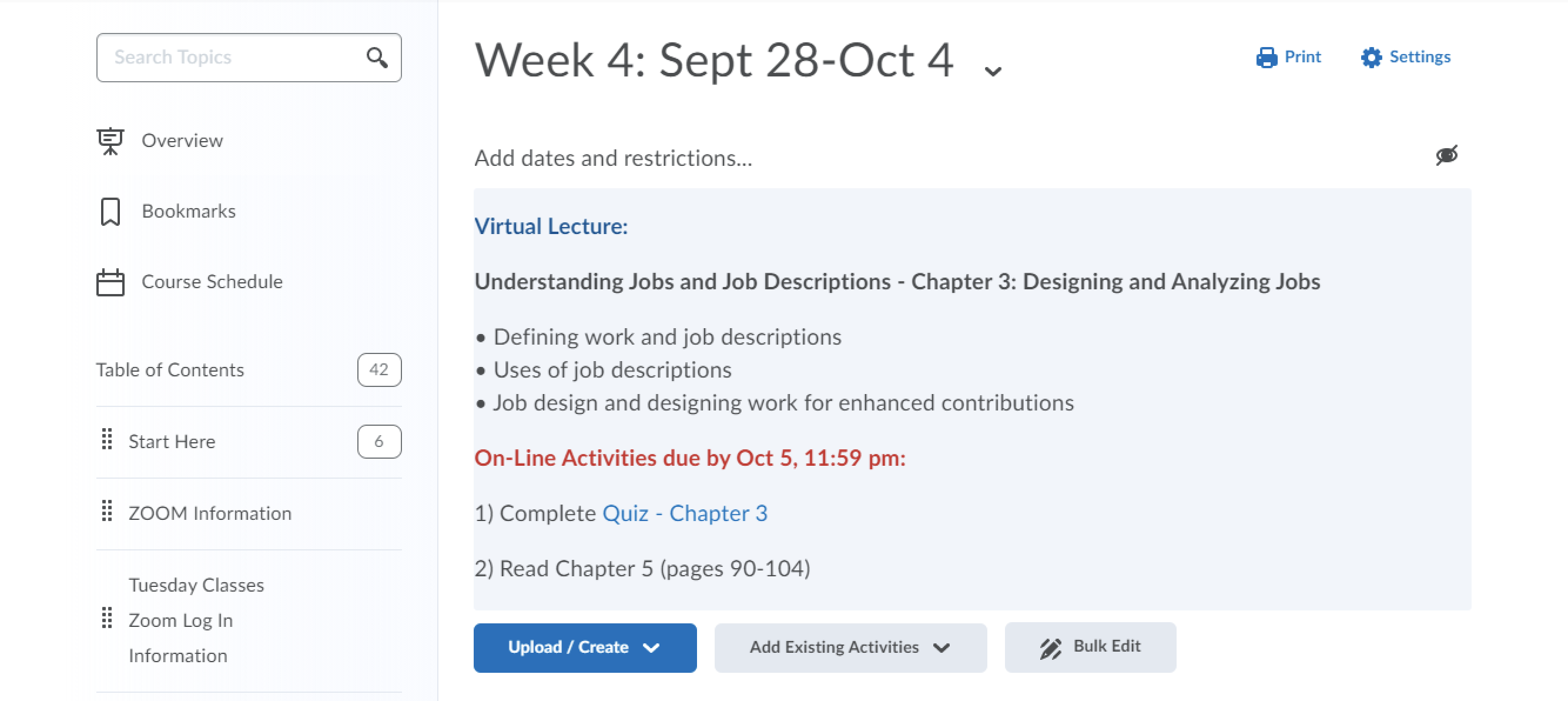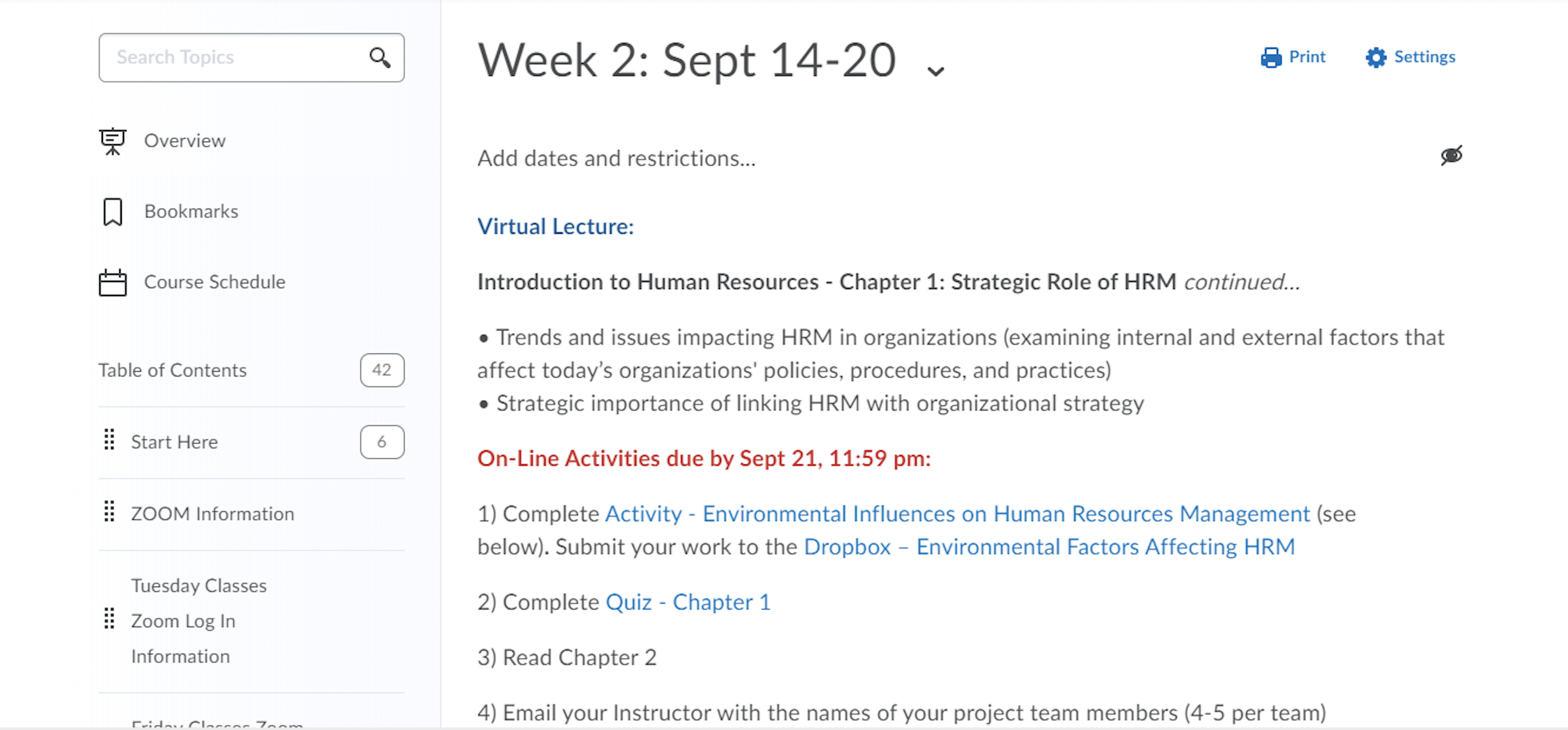Focus on Teaching: Course Navigation and Organization

May is Teaching and Learning Month at the MacPherson Institute and one element of this year’s celebration is a look back at the “Fall Teaching Recommendations” that were released in the fall of 2020 after the Fall Experience Survey.
This has been a challenging year, professionally and personally, for students, instructors and staff at the University. Everyone has had to adapt to uncertainty and changes that have come with remote learning and all of the associated technologies. We are looking back at the Teaching Recommendations to see what they look like in practice and what potential areas of growth, experimentation and improvement have been possible since the fall.
One of the teaching recommendations was centred around ‘Improving Course Navigation / Organization’. The tips were mostly focused on Avenue to Learn organization. (Find the original recommendations here).
One instructor who has experienced some success with course organization is Michelle Ogrodnik, who taught an undergrad course (Science) and co-taught a grad level course in Winter 2021. Michelle uses Avenue checklists as a weekly organization tool that keeps her and her students organized and on track.
Why has it been important to you to focus on Avenue organization?
Michelle: I was balancing a couple of courses and I knew I needed to keep things clear for myself and clear for the students. I thought that if I make my Avenue course shell clear and easy, then that is like a two way win where students can find the material and they don’t feel frustrated – and that I am able to better manage some of the admin on the back end. There are so many moving parts in the online world, it is important to me to stay organized.
How did you get started with your approach?
Michelle: The biggest thing that I promised and committed to myself for this term was to implement Avenue checklists. The main thing for me was breaking things into weeks and each week having a checklist that explicitly made sure I knew what the students needed to do that week and the students knew what was expected of them.
How did you figure out the technical side things?
Michelle: The key to all of this was me figuring out how to use the checklist feature in Avenue. I had attended a MacPherson organized Avenue workshop and they mentioned the checklist feature. That’s when I first learned about it and then decided to explore. I found it pretty straightforward to use and less clunky than some of the things in Avenue that are a little more challenging to pick up and navigate. You can make a checklist simply and do things like add items and link course items to other places. What’s nice is that you can test it and see what the student view looks like as well.
Do you have any tips for others who may want to try using Avenue checklists?
Michelle: The only thing that’s tricky with Avenue checklists is when you create it you have to unhide it even if you unhide that week that it sits in. The checklist is separate, and you need to make sure you unhide the checklist. So, that’s tip for folks thinking about checklists: make sure you unhide it, not just the overall content module.
What kind of workload impact have you felt from focusing on course organization?
Michelle: I wouldn’t say that it takes tones of time but, the time you put into it, I think pays dividends in return when students aren’t lost and reaching out and needing support because they know exactly what you’ve laid out for them for that week. I would plan out every week and release the checklist either Thursday night or Friday morning, depending on how on the ball I was. For the undergraduate course, I would have a meeting with my TAs each week and I would run my list past them and see if anything was missed. For the graduate course, my amazing co-instructor Megan Suttie and I would brainstorm together. There’s just so many moving pieces and balancing between a couple of courses that it can become overwhelming easily. In both classes we tried to organize the checklist items into before class, after class, and sometime this week categories. Some examples of checklist items included submitting assignments, info about when to check for feedback, readings to do before class, or reflections to do after class.
Has focusing on course organization benefited you, as the instructor?
Michelle: It helps the students within your respective course stay organized, but it also helps you make sure that you’re following along with what your students are supposed to be doing and making sure that there’s nothing you need to additionally release or support or check in with about that week because you have spent a little bit of time reflecting on what’s happening. I had two courses and I can count maybe a couple of times where a student reached out for additional information. Otherwise, there were very minimal “I’m feeling lost about what to do this week” type emails from students. I think in the world of constant notifications and heavy inboxes – other instructors might appreciate that, too
Have you gotten any student feedback about this approach?
Michelle: Yes. Rebecca Taylor (Educational Developer, MacPherson Institute) and Vanessa Morris (Educational Development Fellow) came in to do a course refinement for me midway and students seem to really like the organization of the course. Students have also anecdotally shared that the checklists were quite helpful.
Now that you’ve gone through a cycle of teaching this way – are you considering any areas for growth or improvement for the next term?
Michelle: Something I’d like to work on, that I had some challenges with, is navigating the communication flow between Avenue and Teams. So, I was using teams for my synchronous classes and I also had a lot of group projects so they had their own channels to do their own work and we would meet there, and we use channels for breakout rooms. If I had class wide announcements, I would post those to Avenue. I polled my class and asked how they wanted the information, and I followed their lead but at some point in the semester I got the feeling that it still wasn’t ideal for students. I’d like to work to fine tune and streamline the communication flow between Avenue and the additional platforms we use.

Nicole Vincic and Hoda Kamel co-teach Engineering course GenTech 2HR and have had a positive experience focusing on Avenue course organization.
How did you get started with your approach?
Hoda: Nicole has so much experience with Avenue and she used it in her teaching at Mohawk College before we started working together.

How did you figure out the technical side things?
Nicole: We kept it very simple. Within Avenue, we created modules: week one, week two week, three, and so forth. The students would navigate to the correct week and would see the class and then underneath it we would in bullet format indicate what we are covering in lecture along with any attachments, assignments or any other documents students may need. It was very simple that way and then just in that same area of content we would have headers like “Lecture” and “Activities” with any relevant information. Below that there’s the opportunity to have attachments and we would include all our chapter attachments like our PowerPoint and any additional resources that were related to that topic.
Students knew exactly where to find things. So, if we’re talking about week one, they knew exactly where to go in the section on Avenue and we would label in the modules “week one” and then we would do that same thing with Week 2 and so on. Everything they needed, it was in one place.
We use colour coding, too. If there is something that we want to really alert the students about like a reminder about due dates for a major project, we might use red for that. I think those visual clues are helpful for students and we’re consistent with that throughout the format.
Hoda: We still posted announcements through Avenue, along with this week by week organization. Something I learned early on in my teaching career is that it doesn’t hurt to remind and over-remind and remind again. Right now, many students can easily fall behind because they don’t have the social cues from their colleagues and their friends. So, we would send weekly announcements to remind them of things.
Nicole: We also created hyperlinks to things like quizzes. So, if it was “week one: quiz one” they could click on it and it would take them right to the quiz. It was the same thing with assignments that were linked or attached right in the weekly modules. We had a dropbox set up for supporting documents and that was organized with the same naming system. We tried to make it foolproof.
What kind of workload impact have you felt from focusing on course organization?
Nicole: It was a lot of work up front but then once the semester begins it is lighter and worth the initial effort. This way, when a student walks into class on the first day they can see weeks 1 – 14 and everything that will be expected of them each week.
Hoda: The only thing we opened up later were the discussion boards. We created the discussion board rubric and the topics, and we linked to these afterwards as we went. We knew we would have discussion boards, but the topics weren’t finalized at the start. There is still a lot of reminding and communicating but doing this is worth the effort at the start.
Have you gotten any explicit feedback about the organization from your students?
Nicole: I did actually from one student, he said to me “this is probably one of the best laid out courses”. He said he appreciated the clear instructions about what was happening week by week.
What kind of impact this has had on you as instructors in terms of staying organized?
Nicole: It can be overwhelming at times. You teach a class and then the next week you come back like “well, did I cover that?” Whereas now – I can remind myself exactly where we left off. I’ve taught like this for a while because the organization really helps me.
Hoda: I really appreciated this system and I’ve used it since in the other courses I’m teaching after I learned these very valuable from Nicole. It keeps you very organized and everything is clear. I always know what is happening and what I need to remind students about during the lecture. It is something I have really benefited from.
Now that you’ve gone through a cycle of teaching this way – are you considering any areas for growth or improvement for the next term?
Nicole: The Avenue layout itself I would keep the same. I attended a session through MacPherson about activities and student engagement and I’m looking forward to focusing on some of that.
Hoda: If anything, we might reduce some of the weekly activities just to alleviate some of those little mini activities that sometimes the students can do in class. As far as the Avenue course shell, even if we are back in person in Campus I don’t think we would change how that is organized.
Focus on Teaching, Updates


